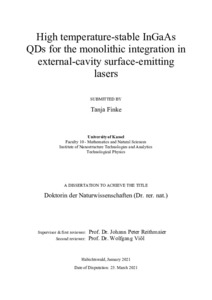| dc.date.accessioned | 2021-04-19T09:04:16Z | |
| dc.date.available | 2021-04-19T09:04:16Z | |
| dc.date.issued | 2021 | |
| dc.identifier | doi:10.17170/kobra-202104163699 | |
| dc.identifier.uri | http://hdl.handle.net/123456789/12721 | |
| dc.description.sponsorship | Deutsche Forschungsgemeinschaft (DFG) | ger |
| dc.language.iso | eng | eng |
| dc.rights | Urheberrechtlich geschützt | |
| dc.rights.uri | https://rightsstatements.org/page/InC/1.0/ | |
| dc.subject | Halbleiterlaser | ger |
| dc.subject | Quantenpunkte | ger |
| dc.subject | Molekularstrahlepitaxie | ger |
| dc.subject.ddc | 500 | |
| dc.subject.ddc | 530 | |
| dc.title | High temperature-stable InGaAs QDs for the monolithic integration in external-cavity surface-emitting lasers | eng |
| dc.type | Dissertation | |
| dcterms.abstract | Optically pumped vertical external-cavity surface-emitting lasers (VECSELs), also called semiconductor disk lasers (SDLs), benefit from the flexibility and versatility of the semiconductor material. With a simple cavity layout, fundamental transverse mode operation with a circular output beam and high beam quality is possible. They have excellent heat-sink properties and only require inexpensive multimode diode lasers for pumping. The complete VECSEL structure is only a few micrometers thick which leads to a strong pump absorption during optical pumping. An ultrafast laser can be established by passive modelocking of the VECSELs with semiconductor saturable absorber mirrors (SESAMs). Hereby, femtosecond or picosecond pulses can be obtained from a simple resonator. By integrating quantum dots (QDs) instead of most commonly used quantum wells (QWs) in the gain and absorber region of these devices, their optical properties could be tailored over a wide range. During this thesis, self-assembled InxGa1-xAs QDs gain material was grown by molecular beam epitaxy and optimized towards high dot density (up to 1.8 × 1011 cm-2) and narrow photoluminescence emission linewidth (26 meV) for the integration in VECSEL and modelocked integrated external-cavity surface-emitting laser (MIXSEL). Complete QD-VECSEL structures were grown by MBE and processed with a solder-based flip-chip bonding technique. A CW setup was designed and built to characterize the fabricated devices. The influence of the number of QD active layers, the heat spreader material and the measurement conditions on the threshold and maximum output power was investigated. Up to 5.7 W output power with a slope efficiency of 34% was achieved at 4 °C heat sink temperature. Furthermore, a new approach for QD-based temperature-stable SESAMs has been developed, in which high-quality InxGa1−xAs QDs grown at 480 °C and modulation p-type doping were implemented. The typically used QD or QW absorber layers grown at very low temperature (< 400 °C) will be annealed during long-term overgrowth and lose their high-speed performance. This new type of QD-SESAM is temperature-stable and suitable for the monolithic integration into MIXSELs. The introduction of recombination centers with p-type modulation doping and additional post-growth annealing improves the absorption of the high-quality QDs. Hence, low saturation fluences below 10 µJ/cm2 and a reduction of the τ1/e recovery time to values below 2 ps were achieved. | eng |
| dcterms.accessRights | open access | |
| dcterms.creator | Finke, Tanja | |
| dcterms.dateAccepted | 2021-03-25 | |
| dcterms.extent | x, 122 Seiten | |
| dc.contributor.corporatename | Kassel, Universität Kassel, Fachbereich Mathematik und Naturwissenschaften | ger |
| dc.contributor.referee | Reithmaier, Johann Peter (Prof. Dr.) | |
| dc.contributor.referee | Viöl, Wolfgang (Prof. Dr.) | |
| dc.relation.projectid | (RE 1110/17-1) QD-MIXSEL Projekt | |
| dc.subject.swd | Halbleiterlaser | ger |
| dc.subject.swd | Quantenpunkt | ger |
| dc.subject.swd | Molekularstrahlepitaxie | ger |
| dc.subject.swd | Optisch gepumpter Halbleiterlaser | ger |
| dc.type.version | publishedVersion | |
| kup.iskup | false | |

